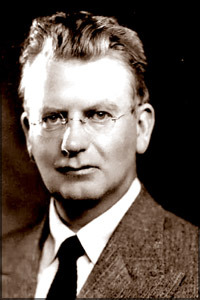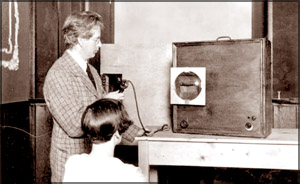John Logie Baird
Pioneer of the television set:
 You
all enjoy watching television, don't you? The TV is now the most popular
form of entertainment in the You
all enjoy watching television, don't you? The TV is now the most popular
form of entertainment in the world and there's rarely a house without a television set, even in our
country. While switching this household item on and off every day, did
you ever stop to think whose brainwave led to this invention which we
cannot live without now?
world and there's rarely a house without a television set, even in our
country. While switching this household item on and off every day, did
you ever stop to think whose brainwave led to this invention which we
cannot live without now?
The first working television was introduced to the world by a
Scottish engineer named John Logie Baird.
Baird was born on August 13, 1888 in Helensburgh, Scotland, the son
of a clergyman. Despite suffering from health problems, he showed signs
of brilliance quite early in life, with some novel ideas.
He followed his education at Larchfield School in Helensburgh and the
Glasgow and West of Scotland Technical College. His studies at the
Glasgow University were disrupted with the advent of the First World
War. Being rejected by the forces as unfit, he started serving as
superintendent engineer of the Clyde Valley Electrical Power Company.
After the war, he started a business, which brought him mixed results.
By this time, many scientists had started working on the dream that
was television; Baird also moved to the south coast of England and
started working on this idea. He first made a rather crude apparatus
with some bits and pieces, and by 1924, managed to transmit a flickering
image across a few feet. On January 26, 1926, he managed to give the
world's first demonstration of true television before a room of fifty
scientists in central London.
|

Demonstrating his invention. |
In 1927, his television was demonstrated over 438 miles of telephone
lines between London and Glasgow, and he formed the Baird Television
Development Company. In 1928, this company achieved the first
transatlantic television transmission, between London and New York and
the first transmission to a ship in mid-Atlantic.
The first television programme for the BBC was also produced by this
company. Baird also gave the first demonstration of both colour and
stereoscopic (three dimensional)television; the first colour
transmission was made on July 3, 1928. In 1932, he became the first
person to demonstrate ultra-short wave transmission.
Although sounds and vision were sent alternately at first, from 1930,
they began simultaneous transmission. However, his invention was
becoming rather outdated in technology and was later dropped in favour
of a more technologically advanced, completely electronic system.
The Baird system, which was used by the BBC to broadcast its TV
programmes from 1929 to 1935, was being used alongside the EMI
electronic scanning system (developed by Marconi) by 1936. The BBC
stopped broadcasts with the Baird system in early 1937.
Despite his invention being dropped in favour of more advanced
systems later, Baird would always be associated with the television due
to his early successes demonstrating working television broadcasts and
his
|

Baird at work |
colour and cinema television work. A working model of his
televisor is displayed at the London Science Museum.
Baird was responsible for many other inventions though not all of
them were successful. Disrupting Glasgow's electricity supply by heating
graphite to create diamonds; turning out a completely rust-resistant
glass razor, which however shattered into pieces; trying to create
pneumatic shoes with semi-inflated balloons which burst; thermal
undersocks which were moderately successful; and a video recording
device (Phonovision) created in 1928 were some of this work.
Baird also worked in fibre-optics, radio direction finding, infrared
night viewing and radar. Although not completely known, he is believed
to have made a major contribution to the development of radar.
The great inventor suffered a stroke in February 1946 and died on
June 14 the same year in Bexhill-on-Sea in Sussex. |
